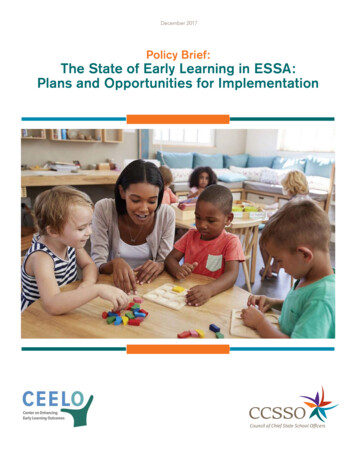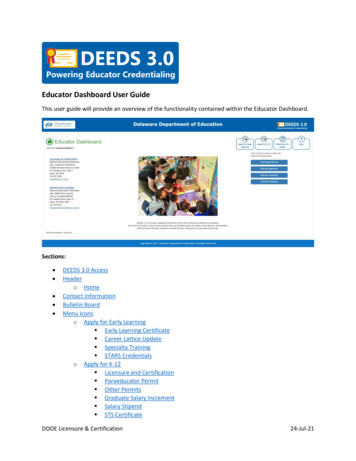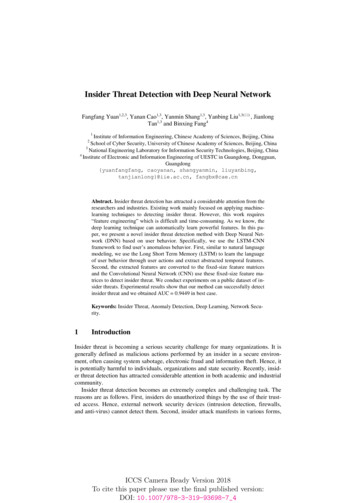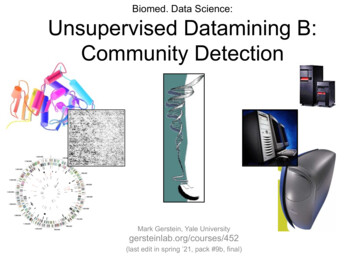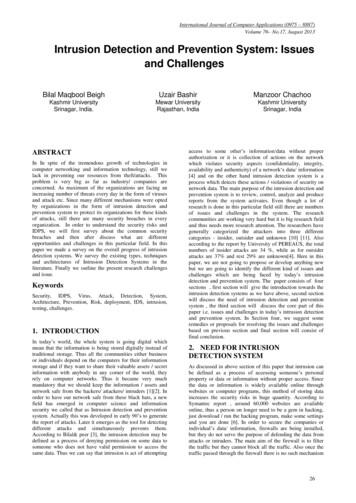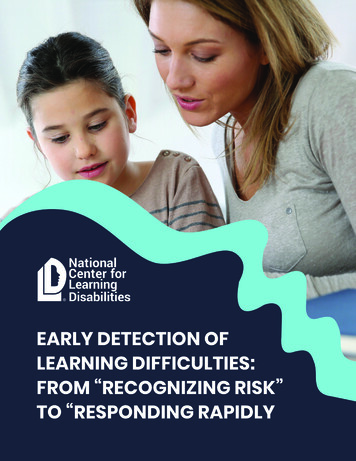
Transcription
EARLY DETECTION OFLEARNING DIFFICULTIES:FROM “RECOGNIZING RISK”TO “RESPONDING RAPIDLY
INTRODUCTIONIntroductionEveryone has trouble with learning and behavior from time to time. But when problems persist, theymay signal an underlying learning disability (LD) or attention disorder (ADHD). Uneven progress or lagsin the mastery of skills and behaviors, even with children as young as 4 or 5, should not be ignored. It’simportant that parents, educators, and other care providers are careful observers and share concernsamong each other so targeted screening or evaluation can take place. Then students can get the helpthey need as quickly as possible—before experiencing self-doubt, frustration, and failure.Early recognition of warning signs, well-targeted screening and assessment, effective intervention, andongoing monitoring of progress are critical to helping individuals with LD to succeed in school, in theworkplace, and in life.For decades, we’ve known how beneficial early education can be for a child’s brain developmentand later success in school, work, and life.1, 2, 3, 4, 5 For example, children who attend high-quality earlyeducation programs are less likely to be placed in special education, less likely to be retained in agrade, and more likely to graduate from high school than peers who didn’t attend such programs.6Despite an increasing number of policy makers calling for universal pre-kindergarten, 2018–2019academic year data indicate that just 34 percent of 4-year-olds and almost 6 percent of 3-year-oldswere enrolled in state-funded preschool. That represents virtually no change from the last few years,according to the State of Preschool 2019: State Preschool Yearbook.7While there may be a stagnation in the rate of enrollment in preschool programs, research aroundbrain-based difficulties has not stopped. In fact, a growing body of research is showing that we canidentify students at risk for learning disabilities earlier and earlier. As policy makers continue topush for universal early childhood education programs, educators, parents, and pediatricians shouldbe aware of characteristics and behaviors that might signal early signs of risk for difficulties withlearning. In particular, advancements in neuroscience around early detection for learning difficulties isespecially exciting. It could lead to early recognition and intervention and, ultimately, the prevention orreduction of difficulties.1.2.3.4.5.6.7.National Research Council. (2000). From neurons to neighborhoods: The science of early childhood development. National Academies Press.Camilli, G., Vargas, S., Ryan, S., & Barnett, W. (2010). Meta-analysis of the effects of early education interventions on cognitive and social development.Teachers College Record, 112(3), 579–620.Burchinal, M., Kainz, K., & Cai, Y. (2011). How well do our measures of quality predict child outcomes? A meta-analysis and coordinated analysis of data fromlarge-scale studies of early childhood settings. In M. Zaslow, I. Martinez-Beck, K. Tout, & T. Halle (Eds.), Quality measurement in early childhood settings (pp.11–31). Paul H. Brookes.Schindler, H., Kholoptseva, J., Oh, S., Yoshikawa, H., Duncan, G., Magnuson, K., & Shonkoff, J. (2015). Maximizing the potential of early childhood education toprevent externalizing behavior problems: A meta-analysis. Journal of School Psychology, 53(3), 243–263.National Scientific Council on the Developing Child (2010). Early experiences can alter gene expression and affect long-term development: Working paper No.10. Retrieved from www.developingchild.harvard.eduMcCoy, D., Yoshikawa, H., Ziol-Guest, K., Duncan, G., Schindler, H., Magnuson, K., Yang, R., Koepp, A., Shonkoff, J. (2017). Impacts of early childhood educationon medium-and long-term educational outcomes. Educational Researcher, 46(8), 474–487.Schulte, B., Durana, A., & Lieberman, A. (2016). The New America Care Report - Policy Recommendations: Universal Pre-K. New America Policy Paper.Early Detection of Learning Difficulties: From “Recognizing Risk” to “Responding Rapidly”2
This is because of how malleable children’s brains are during the early years of development.8,9In 2006, the National Joint Committee on Learning Disabilities defined being ‘at risk for learningdisabilities as “. atypical patterns of development in cognition, communication, emergent literacy,motor and sensory abilities, and/or social-emotional adjustment that may adversely affect latereducational performance.”10 The emergence of innovative research from neuroscientists combinedwith increasingly powerful calls for universal early education programs make this an optimal time forparents and professionals to consider the risk factors, signs, and interventions for young children whoare struggling with learning.This brief is just one of a series of resources that NCLD created as part of The LD Checklist: Recognizeand Respond tool. This includes: The LD Checklist: Recognize and Respond: This interactive tool builds upon the most recentresearch so parents and other caregivers can determine whether a child is at risk for, or showssigns of, having learning disabilities. The more characteristics checked, the more important it is toseek clarification about the presence of underlying learning disabilities. The Importance of Early Screening: This resource provides information on what a screening is andwhy screening for learning difficulties is important. Questions Parents Should Ask Pediatricians If Their Child Seems to Be Struggling Questions Parents Should Ask Educators If Their Child Seems to Be Struggling Resources From Our Partners: In collaboration with researchers, neuroscientists, and otherexperts, we’ve created a collection of high-quality resources that is easy to use and helpful to arange of care providers. To access all of the resources, visit www.ncld.org/LDChecklist.8.9.10.Cantor, P., Osher, D., Berg, J., Steyer, L., & Rose, T. (2018). Malleability, plasticity, and individuality: How children learn and develop in context. AppliedDevelopmental Science, 23(4). 307–337.Johnson, S., Riis, J., & Noble, K. (2016). State of the art review: poverty and the developing brain. Pediatrics, 137(4), e20153075.National Joint Committee on Learning Disabilities. (2007). Learning disabilities and young children: Identification and intervention. A report from the NationalJoint Committee on Learning Disabilities, October, 2006. Learning Disability Quarterly, 30(1). 63–72.Early Detection of Learning Difficulties: From “Recognizing Risk” to “Responding Rapidly”3
RECOGNIZING RISKWhat We Know From Neuroscience ResearchFor many years, we’ve known that the structure and function of the developing brain are shaped bystimulation from the environment after birth.11 An expanding body of neuroscience research furtherconfirms that specific learning disabilities are brain-based and result from a range of disparateneurological factors.12, 13 Recently, large-scale collaborative programs like The Dyslexia PhenotypeProject at the University of California, San Francisco Dyslexia Center are seeking to understand thephenotype (the neural, genetic, cognitive, and behavioral expression) of dyslexia throughout the lifespan,using techniques previously used in memory and Alzheimer’s research. In addition, research is beingconducted by entities such as the Brain Institute, the Math and Numeracy Lab, the Gaab Lab, theNumerical Cognition Laboratory, and the Brain Development Laboratory, using diffusion tensor imaging(DTI), magnetic resonance imaging (MRI), and functional magnetic resonance imaging (fMRI) scans.Neuroscientists are using these techniques to identify structural differences in the brains of people withand without learning difficulties.While most of the neuroimaging research is focused on reading difficulties and disabilities, an increasingnumber of studies are focused on math difficulties, attention issues, and executive functioning inyoung children. Neuroscientists have found that young children who are struggling with learning canhave differences in both brain structure and activation.14, 15, 6, 17, 18, 19, 20 This evidence points towarda more robust understanding of learning difficulties and attention issues and to the importance ofneuroplasticity (the brain’s ability to form new neural connections throughout life) as a guiding principleto improving students’ learning and behavior.21Though these advancements are helpful in our quest to understand these difficulties, some havecriticized “educational neuroscience” as slow to inform interventions for use by practitioners. Even Dr.11.12.13.14.15.16.17.18.19.20.21.Black, M., Walker, S., Fernald, L., Andersen, C., DiGirolamo, A., Lu, C., . & Devercelli, A. (2017). Early childhood development coming of age: science through thelife course. The Lancet, 389(10064), 77–90.National Joint Committee on Learning Disabilities. (2018). What are learning disabilities? Retrieved from https://njcld.org/ ld-topicsLearning Disabilities Association of America. (2018). Core principles: What are learning disabilities? Retrieved from rning-disabilities/Raschle, N., Chang, M., & Gaab, N. (2011). Structural brain alterations associated with dyslexia predate reading onset. Neuroimage, 57(3), 742–749.Im, K., Raschle, N., Smith, S., Grant, P. E., & Gaab, N. (2016). Atypical sulcal pattern in children with developmental dyslexia and at-risk kindergarteners. Cerebralcortex, 26(3), 1138–1148.Specht, K., Hugdahl, K., Ofte, S., Nygård, M., Bjørnerud, A., Plante, E., & Helland, T. (2009). Brain activation on pre‐reading tasks reveals at‐risk status for dyslexiain 6‐year‐old children. Scandinavian Journal of Psychology, 50(1), 79–91.Vandermosten, M., Vanderauwera, J., Theys, C., De Vos, A., Vanvooren, S., Sunaert, S., . & Ghesquière, P. (2015). A DTI tractography study in pre-readers at riskfor dyslexia. Developmental Cognitive Neuroscience, 14, 8–15.Matejko, A., & Ansari, D. (2018). Contributions of functional magnetic resonance imaging (fMRI) to the study of numerical cognition. Journal of NumericalCognition, 4(3), 505–525.Bugden, S., Price, G., McLean, D., & Ansari, D. (2012). The role of the left intraparietal sulcus in the relationship between symbolic number processing andchildren’s arithmetic competence. Developmental Cognitive Neuroscience, 2(4), 448–457.Aguiar, A., Eubig, P., & Schantz, S. (2010). Attention deficit/hyperactivity disorder: A focused overview for children’s environmental health researchers.Environmental Health Perspectives, 118(12), 1646–1653.Wexler, B., Iseli, M., Leon, S., Zaggle, W., Rush, C., Goodman, A., . & Bo, E. (2016). Cognitive priming and cognitive training: Immediate and far transfer toacademic skills in children. Scientific Reports, 6, 32859.Early Detection of Learning Difficulties: From “Recognizing Risk” to “Responding Rapidly”4
John Gabrieli, an esteemed MIT neuroscientist who runs the Gabrieli Lab, agrees that the pace oftranslating brain science into instructional practice is disheartening. Once new knowledge aboutbrain networks comes to light, interventions that are informed by these findings require robust fieldresearch, sometimes expensive technology, targeted professional development, and coordination withschools, parents, teachers, and students. While this foundational work is incredibly important, parents,educators, and pediatricians may find new discoveries interesting but not helpful in determiningwhether a child is at risk for particular types of difficulties—and what, if any, interventions arerecommended based on the hard science.Recognizing Environmental and Genetic Risk Factors andCultural ConsiderationsIn some cases, a student who is struggling may bemisidentified as being “at risk” despite not having anunderlying learning disability. This could be for a varietyof reasons. The Individuals with Disabilities Education Act(IDEA) attempts to prevent misidentification by requiringschools and early education providers to determine whetherany exclusionary factors are at play. Education professionalsmust consider whether, in comparison with their peers, astudent’s lack of success might be primarily attributed tosomething other than a learning disability. While the lawattempts to require schools to distinguish between studentswho are having difficulty in school due to a learning disabilityand those who might be showing signs of difficulty due toother factors or circumstances, it can be hard to make thisdetermination in practice. In addition to there being no testto “diagnose” LD, nor a detailed menu of discernible causesfor learning disabilities, many factors—such as the child’senvironment, cultural background, language development,family economic status, and developmental history—eachplay a role in, and have an impact on, a child’s learning.22.Exclusionary FactorsEducation professionals mustdetermine that the followingfactors are not the primarycause for learning dificulties: Visual, hearing, or motordisabilitesIntellectual disabilitesEmotional disturbanceEnvironmental, cultural, oreconomic disadvantageLimited English proficiencyIndividuals with Disabilities Education Act, 20 U.S.C. § 602 (2004).Early Detection of Learning Difficulties: From “Recognizing Risk” to “Responding Rapidly”5
Environmental FactorsThere is a long history of studies looking at the risk factors and signs of learning difficulties in youngchildren. Unsurprisingly, brain development can be negatively impacted in children by such factorsas poverty, lack of appropriate nutrition, stress associated with violence and trauma, or exposure totoxic materials.23,24,25 In addition, a child’s brain development can be negatively impacted by maternalfactors, including poor nutrition and mental health disorders (e.g., depression).26 Furthermore,correlations have been shown between levels of parental education and children’s brain development.27However, there is no evidence that any of these factors necessarily cause learning difficulties.With regard to disorders of attention, research has pointed to risk factors, including prenatal substanceexposures (e.g., heavy metals, chemicals), nutritional factors, and lifestyle/psychosocial factors.There is a well-established link between lead exposure and ADHD, and growing but more limitedevidence that suggests an increased ADHD risk with exposure to manganese, organophosphates,and phthalates. Recent studies provided additional evidence for an association between ADHD andlow zinc and omega-3 fatty acid levels in children.28 Other studies show maternal folate levels duringpregnancy and childhood “Western” dietary patterns, as well as maternal obesity during pregnancy, aspossible risk factors for childhood ADHD.29 Finally, psychosocial adversity (e.g., maternal stress duringpregnancy, early traumatic experiences, and early institutional care) may increase the risk for ADHD.30Genetic FactorsAnother factor that caregivers, pediatricians, and early educators should be aware of is that childrenare likely more at risk if their parents and close family relatives also struggled with learning andattention issues. Reports in the pediatric literature suggest that as many as 49 percent of parentsof children with dyslexia also report significant challenges with reading.31 And about 40 percent ofsiblings were found to struggle with reading. In addition, the risk of ADHD in parents and siblings ofchildren with ADHD is increased two to eight times, with heritability estimated at 76 percent, basedon pooled data from twin studies. 32 Researchers have clearly demonstrated that there is a strongfamilial component to dyslexia, but the precise genetic nature of this well-researched disorder remains23.24.25.26.27.28.29.30.31.Felitti, V., Anda, R., Nordenberg, D., Williamson, D., Spitz, A., Edwards, V., & Marks, J. (1998). Relationship of childhood abuse and household dysfunction to many of the leadingcauses of death in adults: The adverse childhood experiences (ACE) study. American Journal of Preventive Medicine, 14(4), 245–258Lacour, M., & Tissington, L. (2011). The effects of poverty on academic achievement. Educational Research and Reviews, 6(7), 522–527.Walker, S., Wachs, T., Grantham-McGregor, S., Black, M., Nelson, C., Huffman, S. L., . & Gardner, J. (2011). Inequality in early childhood: risk and protective factors for early childdevelopment. The Lancet, 378(9799), 1325–1338.Ibid.Noble, K., Houston, S., Brito, N., Bartsch, H., Kan, E., Kuperman, J., . & Schork, N. (2015). Family income, parental education and brain structure in children and adolescents. NatureNeuroscience, 18(5), 773–778.Froehlich, T., Anixt, J., Loe, I., Chirdkiatgumchai, V., Kuan, L., & Gilman, R. (2011). Update on environmental risk factors for attention-deficit/hyperactivity disorder. Current PsychiatryReports, 13(5), 333–344.Howard, A., Robinson, M., Smith, G., Ambrosini, G., Piek, J., & Oddy, W. (2011). ADHD is associated with a “Western” dietary pattern in adolescents. Journal of Attention Disorders,15(5), 403–411.Sagiv, S., Epstein, J., Bellinger, D., & Korrick, S. (2013). Pre- and postnatal risk factors for ADHD in a nonclinical pediatric population. Journal of Attention Disorders, 17(1), 47–57.Shaywitz, S., & Shaywitz, B. (2005). Dyslexia (specific reading disability). Biological Psychiatry, 57(11), 1301–1309.Early Detection of Learning Difficulties: From “Recognizing Risk” to “Responding Rapidly”6
unknown. The term “learning disabilities” refers to a number of different types of disorders. And nocommon genetic factors have been identified to predict the onset of LD or to validate the presence ofsubtypes of LD in any population.Cultural Considerations and English LearnersFinally, educators and pediatricians should consider the cultural and linguistic background offamilies in children deemed to be at risk for learning difficulties. This is especially important to takeinto account when differentiating perceived learning disabilities from typical language acquisitionchallenges. For example, a child may exhibit many of the signs of a language difficulty if theycome from a household where mainstream English is not spoken. Recent research has shown theimportance of considering linguistic variation both in the assessment and instruction of spelling skills,especially among African American children who speak African American English (AAE). For example,one study found that typically achieving children who spoke AAE shared a specific behavior that hasbeen observed among students with learning disabilities: variable omission of inflected endings onwritten tasks. The study concluded that “because typically achieving African American children whospeak AAE may exhibit skill profiles that look similar to those of students with learning disabilities,clinicians and teachers must take care to ensure that errors based on language differences are notmisinterpreted as errors based on learning difficulties.” Furthermore, English language learners canhave particular challenges with reading, writing, or speaking as they work to become proficient withthe English language. This might lead to misidentification of a learning disability. Those determiningeligibility for special education services should use culturally responsive assessments to avoid riskingimproper identification.35In sum, the existence of environmental, genetic, or linguistic and cultural factors should notautomatically disqualify a child from being identified as having a learning disability. Rather, they shouldbe seriously considered as part of an examination of the child’s development. Environmental, genetic,and cultural factors cannot predict learning difficulties. It is important to understand these factorsand their role in a child’s development so they do not lead to the misidentification of students needingspecial education.32.33.34.35.Franke, B., Neale, B., & Faraone, S. (2009). Genome-wide association studies in ADHD. Human Genetics, 126(1), 13–50.Patton-Terry, N., & Connor, C. (2010). African American English and spelling: How do second graders spell dialect-sensitive features of words? Learning Disability Quarterly, 33(3),199–210.Ibid.Flanagan, D., Ortiz, S., & Alfonso, V. (2013). Essentials of cross-battery assessment (Vol. 84). John Wiley & Sons.Early Detection of Learning Difficulties: From “Recognizing Risk” to “Responding Rapidly”7
Recognizing Early SignsRecognizing Early At-Risk Signs for Reading/Writing/Language DisordersThere are many signs that parents, educators, pediatricians and others should look for whendetermining if a young child may be at risk for reading disabilities. These include: Trouble naming letters (e.g., confuses similar looking letters and numbers)Difficulty recognizing the small units of sounds (phonemes) in spoken wordsDifficulty tapping or clapping out the syllables in wordsProblems connecting letters to the sounds they makeTrouble blending sounds together to make wordsNeeding to sound out words already encountered in printed textPoor retention of new vocabularyAs is the case with all types of learning disabilities, students who struggle with learning and attentionmay demonstrate slow processing speed and have weaknesses with working memory skills.Children who have underdeveloped phonological processing and/or oral language skills that underliedecoding are at increased risk are at increased risk of being identified as having reading disabilities.36Furthermore, fluent reading also depends on orthographic processing, i.e., the ability to identify writtenletter patterns and words as whole units (rather than letter by letter). Recent studies have shown thatthese types of weaknesses can sometimes be identified in children as early as the preschool years.Reading and writing difficulties often co-occur and are widely seen as related. However, there is lessagreement on the exact relationship between the two.37 Specific to writing disabilities, there are manysigns that could determine if a young child may be at risk. These include: 36.37.Disliking and avoiding writing or copyingDemonstrating delays in writing or copyingHaving difficulty remembering shapes of letters and numeralsFrequently reversing or misdrawing letters, numbers, and symbolsHarm, M., & Seidenberg, M. (2004). Computing the meanings of words in reading: Cooperative division of labor between visual and phonological processes. PsychologicalReview, 111(3), 662–720.Wengelin, Å., & Arfé, B. (2017). The complementary relationships between reading and writing in children with and without writing difficulties. In Miller, B., McCardle, P., &Connelly, V. (Eds.), Writing development in struggling learners (pp. 29–50). Brill.Early Detection of Learning Difficulties: From “Recognizing Risk” to “Responding Rapidly”8
Additionally, there are many signs that might point to riskfor language disorders. These include: IDENTIFIED EVALUATEDSome ChildrenCheck out the AmericanEarly delays in learning to speakSpeech-Language- Association’sDifficulty modulating voice (e.g., too soft, too loud)(ASHA) resources aroundTrouble naming people or objects in conversationcommunications disordersDifficulty staying on topicfrom their “Identify the Signs”Inserting invented words into conversationDifficulty re-telling what has just been saidTrouble engaging in long conversationsUsing vague, imprecise language and having a limited vocabularyDemonstrating slow and halting speech, using lots of fillers (e.g., uh, um, and, you know, so)Using poor grammar or misusing words in conversation (note: take into account regional andcultural factors)Mispronouncing words frequentlyStruggling with rhymingHaving limited interest in books or storiesHaving trouble understanding instructions or directionsRecognizing Early At-Risk Signs for Math DisordersCompared to the area of reading and literacy, there is much less research on early signs or at-riskfactors in the area of math (numeracy). However, like reading, factors such as processing speed,temporal processing, and memory skills may contribute to difficulties in this area. In addition,home experiences such as the frequency with which parents reported informal activities that havequantitative components (e.g., board and card games, shopping, cooking) may influence whetherchildren experience math learning difficulties later on.38 Finally, there are indications that poorexecutive functioning skills are related to math difficulties.39,40There are a few potential at-risk signs relating to “number sense” that parents, educators,pediatricians, and others should look for when determining if a young child may have mathdisabilities.41 Number sense has two basic components.42 The first is related to counting and itsunderlying digital, sequential, and verbal structure. The second component is related to quantitydiscrimination. For example, which is more, 5 or 3? (Some students may be able to count to 5 without38.39.40.41.42.LeFevre, J., Skwarchuk, S., Smith-Chant, B., Fast, L., Kamawar, D., & Bisanz, J. (2009). Home numeracy experiences and children’s math performance in the early school years.Canadian Journal of Behavioural Science/Revue canadienne des sciences du comportement, 41(2), 55–66.Toll, S., Van der Ven, S., Kroesbergen, E., & Van Luit, J. (2011). Executive functions as predictors of math learning disabilities. Journal of Learning Disabilities, 44(6), 521–532.Clark, C., Pritchard, V., & Woodward, L. (2010). Preschool executive functioning abilities predict early mathematics achievement. Developmental Psychology, 46(5), 1176–1191.Jordan, N., Kaplan, D., Nabors Oláh, L., & Locuniak, M. (2006). Number sense growth in kindergarten: A longitudinal investigation of children at risk for mathematics difficulties. ChildDevelopment, 77(1), 153–175.Case, R., Okamoto, Y., Griffin, S., McKeough, A., Bleiker, C., Henderson, B., . & Keating, D. (1996). The role of central conceptual structures in the development of children’s thought.Monographs of the Society for Research in Child Development, 61(1-2), 1–295Early Detection of Learning Difficulties: From “Recognizing Risk” to “Responding Rapidly”9
error, but cannot say which number is bigger, 5 or 3.) While researchers agree that these two keycomponents of number sense are not well linked, there is consensus that these two foundational skillsare precursors of other components of number sense, such as estimation and the ability to moveacross representational systems. These components include: Counting: Grasping one-to-one correspondence, knowing stable order and cardinality principles,and knowing the count sequenceNumber knowledge: Discriminating and coordinating quantities, making numerical magnitudecomparisonsNumber transformation: Transforming sets through addition and subtraction, calculating in verbaland nonverbal contexts, calculating with and without referents (physical or verbal)Estimation: Approximating or estimating set sizes, using reference pointsNumber patterns: Copying number patterns, extending number patterns, and discerning numericalrelationshipsAny indication that a young child struggles with number sense could be a sign that the child willstruggle with math learning. However, here are some particular signs that parents, educators,pediatricians, and others should look for when determining if a young child may be at risk for mathdisabilities. These include: Difficulty with simple counting and one-to-one correspondence between number symbols andobjectsDifficulty recognizing quantities without countingDifficulty estimating (e.g., quantity, value)Difficulty with comparisons (e.g., less than, greater than)Trouble telling time (on either a digital or analog clock)Recognizing Early At-Risk Signs for Attention DisordersAttention issues are complex with great heterogeneity in the behavioral characteristics presentedand in brain functions and structures affected. Problems with executive functioning are hallmarkcharacteristics of disorders like ADHD, and individuals with this disorder struggle to modulateattentional skills that are key to learning. Several aspects of attention and executive function which arekey to learning—particularly vigilance, working memory, and response inhibition—are compromised inchildren with ADHD.43According to Children and Adults with Attention-Deficit/Hyperactivity Disorder (CHADD), children asyoung as 4 years old can be diagnosed with ADHD. Preschoolers with ADHD often have difficulties43.Understood. (2020, April 17). What is executive function? Retrieved June 08, 2020, from ctioning-issues/what-is-executive-functionEarly Detection of Learning Difficulties: From “Recognizing Risk” to “Responding Rapidly”10
in daycare or school settings, including problems with peer relationships and content learning. Forpreschoolers and young school-age children, behavioral treatments (involving all care providers,including parents and school personnel) should be considered before prescribing medication, butpharmacological intervention is a safe and effective option with careful monitoring and regularmedical supervision. Important signs to look for in young children include difficulty sustainingattention in play activities and work tasks compared to their peers, and problems staying on taskacross a variety of different settings. For school-age children and older, the following behaviors mayindicate being at risk for attention disorders: Failing to pay close attention to details or making careless mistakes in schoolwork, work, or otheractivitiesStruggling to sustain attention in play activities and work tasksNot appearing to listen when spoken to directlyNot following through on instructionsFailing to finish schoolwork, chores, or duties in the workplaceHaving trouble organizing tasks and activitiesAvoidin
push for universal early childhood education programs, educators, parents, and pediatricians should be aware of characteristics and behaviors that might signal early signs of risk for difficulties with learning. In particular, advancements in neuroscience around early detection for learning difficulties is especially exciting.
